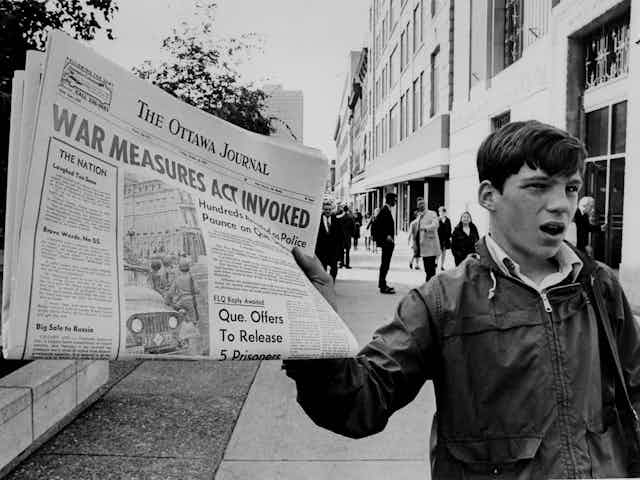The FLQ’s October 1970 Manifesto, delivered 50 years ago this month, is one of the best ever written polemical pieces in Canadian history. It stands somewhere in the literary pantheon with the Co-operative Commonwealth Federation’s Regina Manifesto, Refus Global and a few other texts.
Such a statement may seem puzzling given that it was released shortly after the kidnapping of James Cross, the British trade commissioner, in October 1970 in Montréal, soon followed by the kidnapping and murder of Pierre Laporte, Québec’s labour minister.
However, a careful reading of the manifesto reveals why it struck a chord among many French-speaking Quebecers. Four elements can be underscored that are common to almost all great political speeches in history:
-
Setting
Dialectic of anger and hope
Personalization of the issues
Empowerment
The setting
The setting in which a document is delivered to the public is always important. The broadcast of the FLQ manifesto is no exception.
Listed among the seven demands for Cross’s release, the manifesto was read on French CBC on Oct. 8 by announcer Gaétan Montreuil.
The contrast was stark between Montreuil’s impeccable co-called “international” French, his dull and flat tone of voice, his tailored suit and the manifesto’s use of joual (colloquial Canadian French) and very crude images.
In a way, the CBC’s setting elevated the manifesto. It clothed it in respectable garment.

In 1968, playwright Michel Tremblay caused an outrage when he let actors use joual. In 1969, rock singer Robert Charlebois inflamed young crowds with his songs in joual.
The broadcast of the FLQ Manifesto had a similar impact. For the first time, working-class viewers were hearing themselves represented on national television.
Anger and hope
The manifesto employed some coarse language. It was vulgar, prejudiced and accusatory.
It stated that the FLQ wanted to purge Québec “of the clique of voracious sharks, the patronizing ‘big bosses’ and their henchmen who have made Québec their private hunting ground for cheap labour and unscrupulous exploitation.”
Using the highly effective rhetorical tool of reiteration, the manifesto underscored how people in Québec were fed up.
“We have had our fill,” repeats the manifesto many times. Quebecers had had “their fill” of abuses, lies and contempt.
Anger, as we know, is perhaps the most powerful emotion driving mobilization. “I’m as mad as hell and I’m not going to take it anymore,” famously shouts Howard Beale in the 1976 film Network. In 1970, many Quebecers were “mad as hell.”
However, having detailed Quebecers’ frustration, the FLQ manifesto ended on a hopeful note:
“Our struggle can only be victorious. An awakening people cannot be kept in misery and contempt for long.”
One day soon, concluded the FLQ, Quebecers will be able to live in “a free society, operating by itself and for itself, a society open to the world.” Having lived for so long in darkness, they would see the light.
Personalization
The FLQ manifesto didn’t describe the situation in the abstract. On the contrary, it personalized the issues.
It talked about specific strikes and working-class struggles. It spoke of the workers at Ayers, Seven-Up, Victoria Precision, Dupont, Domtar, the blue-collar workers in Laval and Montréal, the milk producers, the police officers, the fishermen of the Gaspé, the workers of the North Shore, the miners, the welfare recipients, Montréal taxi drivers, etc. And it addressed people by their name.
It talked about “Mr. Bergeron of Visitation Street” and “Mr. Legendre of Laval,” who didn’t earn a decent living and didn’t “feel free in our country of Québec.”
It talked about “Mr. Tremblay of Panet Street” and “Mr. Cloutier, who works in construction in St. Jérôme” and constantly felt betrayed by corrupt politicians.
It talked about “Mrs. Lemay of St. Hyacinthe,” who could not “pay for little trips to Florida like the rotten judges and parliamentarians do with our money.”
By making the issues personal, the FLQ manifesto felt real. It gave the impression that the oppression of working-class francophones was not something its authors had simply read about in books.
Empowerment
The FLQ manifesto called for a revolution. But this revolution was not to be led by ringleaders and avant-garde activists.
The first line of the FLQ manifesto is unambiguous in this regard: “The Front de libération du Québec is neither the Messiah nor a modern-day Robin Hood.”
If Quebecers were to take control of their destiny, they would have to rise up from where they were. They would have to count first and foremost on themselves.
The manifesto ends with a clear rallying cry to all Quebecers:
“Factory workers, miners and loggers; service-industry workers, teachers, students and the unemployed, take back what belongs to you, your jobs, your determination and your liberty …. Don’t wait for some miracle organization. Make your own revolution in your neighbourhoods, in your places of work. If you don’t do it yourselves, other technocratic usurpers and so on will replace the handful of cigar smokers we now know, and everything will have to be done over again. Only you are able to build a free society.”
Actions speak louder than words
After the FLQ manifesto was broadcast on Oct. 8, 1970, French-speaking Quebecers felt uplifted. It expressed many of their concerns.
But on Oct. 17, when Laporte was found dead in the trunk of a car, murdered in cold blood by his FLQ kidnappers, the FLQ manifesto took an altogether different meaning. It was no longer a respectable, hopeful and empowering document that Quebecers could relate to.

The fact that the FLQ cell that assassinated Laporte was not the same one that composed the manifesto did not matter. Both were in solidarity.
They should have known that actions speak louder than words.


